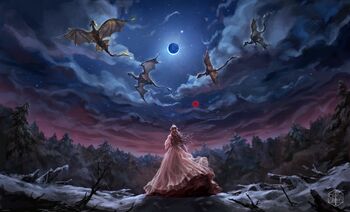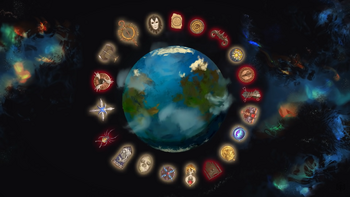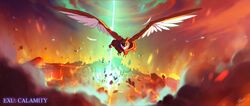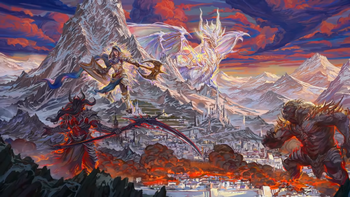For me, our greatest purpose has passed, the moment we granted your forebears the spark to seek their own purpose. We now stay to inspire, to guide, to guard the Gate, to keep the hate of ignorance we spawned in our hubris from burning away everything. The rest is up to you. We need you, perhaps, but you do not need us.
Since the gods first came to Exandria, four distinct ages of the world have gone by: the Founding, the Age of Arcanum, the Calamity, and the Post-Divergence era. The events of Critical Role take place in the fourth age.[2]
For a timeline of Exandrian history as it is now known, with dates, see the article Timeline.
Before the Founding[]
According to the creation myth believed by followers of the Luxon, a single Light emerged from the darkness at the creation point of the universe. Other lights formed around this Light, but those lights settled as stars; the single Light (which was later called the Luxon) resisted that urge to burn and instead traveled, seeking self-knowledge.[3] The Luxon traveled without much comprehension, knowing only that they were light in the darkness, and occasionally passed other things of light.[4]
The Luxon, having noticed a particular lonely planet, began to embrace the world and gave their light to the planet, cracking the surface and giving it fiery life. The elemental chaos gave birth to titans called Primordials, and they erupted and fought each other[3] and the Luxon.[5] Finding no consciousness in the elemental chaos and seeing the Primordials' souls being lost to the darkness beyond as they killed each other, the Luxon broke into scattered Luxon beacons that would enact a cycle of rebirth for those who were bound to their light, in hopes that those beings would gradually learn and mature, and one day something would find and reassemble the Luxon, at which point the Luxon would ask them, "What am I, and what is my purpose?"[3]
When shards of the Primordials Rau'shan and Ka'Mort awoke within Fearne Calloway and Ashton Greymoore respectively, they experienced visions of a time when the land was still forming in a process of intermingled creation and destruction, "all the elements swam between each other",[6] and smaller elementals played and merged and vanished.[7]
The Founding[]
The Founding is widely considered the first age of Exandria,[2] which started when the deities arrived on the planet, allegedly meeting the titans for the first time at the Ascendant Bridge Mountain in Issylra.[9] During this time, the gods brought forth creatures to inhabit Exandria, before splitting into two factions in the war against the Primordial Titans: the Prime Deities and the Betrayer Gods. The age ended with the defeat of the Primordials, along with the Betrayer Gods, which made the world safe for civilization to flourish.
The protean creators[]

Official art of the creation of the dragons, by Ameera.[art 1]
During this first age, gods brought forth the elves, dwarves, and humans, along with as many other races as they had inspiration for. Because the world was still a dangerous place, ruled by elemental chaos, many of their children were killed in the earliest days. Saddened by the loss of so many children, the gods gifted mortals with arcane magic so they might better defend themselves. The Dragons Metallic were created to aid in the defense of the Children of Creation. With the dragons' help, civilization began to flourish and mortals first offered worship (and purpose) to their creators.[8]
The Primordials[]

Official art of four elemental titans, by Kent Davis from "Exandria: An Intimate History" (Sx61) at 1:42.[art 2]
These Elemental Titans had lain beneath the land since before the coming of the gods and now rose up to wreak havoc on the gods' creations. Their carnage invited the attention of demons from the Abyss, who came to feast on the remains.[10]
Predathos[]

Fan art of the creation of Ruidus, from Exandria: An Intimate Appendix - Ruidus and the Gods, by Wesley Griffith.[art 3]
At some point after the deities interacted with the elemental titans for the first time, a mysterious entity called Predathos reached Exandria. This entity created twisted life forms in the world and didn't fear the deities, since it resisted their magic, and eventually attacked, devouring first Ethedok the Endless Shadow, god of darkness and winter, and then Vordo the Fateshaper, god of fate and order. After losing two of their own, the remaining deities collaborated with the elemental forces of Exandria, and together they imprisoned Predathos, trapping it with a piece of planet that (despite their attempt of sending it far away) would become the second moon, Ruidus, orbiting Exandria to this day.[11]
The Prime Deities vs. the Betrayer Gods[]

Screenshot of Prime Deities and Betrayer Gods, by Cyarna Trim and Conceptopolis from "Exandria: An Intimate History" (Sx61) at 2:22.[art 4]
Despite their brief collaboration with the gods, the Primordials continued devastating the divine creation, and two factions arose between the deities, in an event known as the Schism: the Prime Deities wished to stay and conquer the Primordials, leaving the land safe for their children; the Betrayer Gods, frustrated by their losses, gave up, and some gave in to madness, while others began twisting their creations and joining forces with the Abyss.[10]
The Prime Deities, with the help of their mortal champions, ultimately destroyed the Primordials and banished the Betrayer Gods from the Material Plane.[10]
The earth titan[]
The fate of one of these defeated Primordials, an earth titan, is known to Vox Machina. This titan was thrust feet-first[12] into the earth in northern Issylra, with such great force that the impact created the Zenwick Mountains.[13] It lay there for an eternity, its remains excavated for precious metal in the early Age of Arcanum by dwarves whose society eventually collapsed into madness and cannibalism, until it was reanimated by Vecna.[14]
The founding of Vasselheim[]
With peace finally achieved, the first true civilization was able to take root. It was called Vasselheim, the "Dawn City" and the "Cradle of Creation."[10]
The Age of Arcanum[]
The Age of Arcanum was the second epoch of Exandria.[2] It began over 1,500 years prior to the events of Critical Role.[15] During this time, mortals tested the limits of arcane power, challenged the gods who had created them, and brought about the escape of the once-defeated Betrayer Gods. This era has also been called "the Age of Wanton Necromancy," as there were no laws against it at the time.[16]
Arcane ambition[]

Official art of a flying city during the Age of Arcanum, by Robin Olausson.[art 5]
Mortal mages grew ever more powerful, building entire castles in a day and even learning to create life-forms of their own. Driven by the quest for immortality, an unnamed mortal woman challenged and defeated the God of Death himself, ascending to take his place in the pantheon.
One man, Archmage Vespin Chloras, sought to harness the power of the Betrayer Gods. He broke open their prison, where they had been spawning hungry creations of their own, and released them back into the Material Plane during an apogee solstice.[10]
The destruction of Domunas[]
Part of the Betrayer Gods' initial plans was to free two elemental titans, Rau'shan the Emperor of Fire and Ka'Mort the Empress of Earth, defeated and sealed away by the Dawnfather and the Wildmother under Mount Ygora, in Domunas, during the Schism;[17][18] an alliance between those primordials and the newly freed deities would have doomed the Prime Deities and their creations.[19]

Fan art of Cerrit Agrupnin escaping the destruction of Domunas, by Lap Pun Cheung.[art 6]
Vespin Chloras and Asmodeus performed different manipulations to guarantee this result, which would be triggered when the two halves of the ancient city of Toramunda (Avalir and Cathmoíra) were reunited on the mainland; however, they did not count on the determination of the Ring of Brass, a group of powerful friends from Avalir who made sure to evacuate people and ruin the plans of the Lord of the Hells, using the Astral Leywright invented by Laerryn Coramar-Seelie to send the Emperor of Fire and the Empress of Earth out of Exandria via a new ley line, destroying them in the process, but also annihilating the continent of Domunas by the massive release of energy. The archipelago known as the Shattered Teeth is all that remains of the continent that was once called "the smile of Exandria".[20]
Ghor Dranas[]
Driven by an urge for domination, the exiled gods came forth from their broken prisons, enthralled the mage who had freed them, and founded a kingdom of their own on the far end of the world. The kingdom was called "Ghor Dranas"[10] (which means "gathering of shadows" in Draconic[21]), and was located in the region which would later become Xhorhas in Wildemount.[22] The city of Rosohna was built on the ruins of Ghor Dranas.
Assault on Vasselheim[]

Official art of Erathis and Bahamut battling Asmodeus and Gruumsh at Vasselheim, by Kent Davis from "Exandria: An Intimate History" (Sx61) at 3:53.[art 7]
From Ghor Dranas, the Betrayer Gods spread their influence and eventually made an assault on the bastion of Vasselheim. The battle lasted twenty days and nights but, with the divine aid of the Prime Deities, Vasselheim and its inhabitants stood triumphant, if battered, at the end.[10]
This assault left both mortals and gods alike shaken. Mortals turned their arcane powers to the forging of heroic weapons, and the gods prepared for war.[23]
The Calamity[]
The Calamity was the third age of Exandria.[2] The exact timeframe is uncertain, but it is known that Ioun, who was wounded during this age, has been recovering for at least 800 years.[24] This age encompasses the second war against the Betrayer Gods, which devastated civilization and in some cases rearranged the geography of the world. The age ends with the defeat of the Chained Oblivion and the construction of the Divine Gate.
Divine warfare[]

Official art of Erathis battling Asmodeus during the Calamity, by Kent Davis.[art 8]
Following the assault on Vasselheim, conflict against the Betrayer Gods was rejoined. Most cities that had sprung up during the Age of Arcanum were reduced to ash, leaving Vasselheim once again as the sole bastion of civilization. Historians estimate that no more than a third of the world's population survived this war.[23]

Official art of Ioun battling Tharizdun, by Wesley Griffith.[art 9]
To end the war, the Prime Deities sought to banish Tharizdun, the Chained Oblivion. During their battle, Ioun, the Knowing Mistress, took a near-fatal blow, from which she is still recovering. However, the Rites of Prime Banishment were successfully enacted for the first time in history, and Tharizdun was vanquished.
A long recovery[]
In the end, the kingdom of Ghor Dranas was defeated and the Betrayer Gods banished once more, but now with the knowledge and fear that they could return again. While the mortal world recovered slowly from the devastation it had endured, the Prime Deities were left to ponder how they might prevent a third divine war.[23]
The Divergence[]
Hoping to seal away the Betrayer Gods for good, the Prime Deities retreated from the Material Plane. Behind themselves and their defeated brethren, they erected a barrier known as the Divine Gate, which would prevent any god from physically crossing over into mortal realms.[23]
The departure of the gods from Exandria, and the diminishing of their influence, was an event that has since come to be known as "The Divergence."[23]
Post-Divergence[]
The events of Critical Role take place during the fourth age of Exandria.[2] This timespan encompasses all of modern history since the Divergence. Monks of the Cobalt Soul and other historians label and number the years in the Calendar of Exandria as "PD", or "Post Divergence". For example, at the start of Critical Role's second campaign, the year is 835 PD.
Influence of the gods[]
Though unable to physically cross over into Exandria, both the Prime Deities and the Betrayer Gods still grant boons from afar to their mortal followers. Vasselheim remains as the bastion city of the Prime Deities, where divine magic is common but arcane magic tightly regulated for its role in unleashing the Calamity.
Vestiges of the Divergence[]
The Vestiges of Divergence are powerful relics from the war against the Betrayer Gods that remain scattered throughout the Planes of Existence. Eight of these relics have been gathered together by a group of heroes known as Vox Machina, though more remain lost.
Ascension of a new god[]
The arch-lich Vecna once again pressed the limits of arcane power. In "The Endless Atheneum" (1x106), for only the second time in the history of the world, a mortal attained the power of a god.[26] Vecna sought then to gather worshipers and expand his power,[27] while the Prime Deities sought to defeat him as the Betrayer Gods were once defeated.
Unlike during the last war, the Divine Gate stood as a barrier between the Prime Deities and the newly ascended Vecna, who came to power on the mortal side of the gate.[28] It seemed that the responsibility for his banishment would therefore fall upon a select few mortal champions, bearing the gifts of their gods from across the Divine Gate.
Vox Machina, guided by blessings from Ioun, Pelor, Sarenrae, and the Raven Queen, took it upon themselves to confront and seal away Vecna. Atop his tower in the moving city of Thar Amphala, as Vecna led yet another assault against Vasselheim, they confronted the new god. By enacting the same Rites of Prime Banishment that were used to seal away the Chained Oblivion, they successfully exiled him from the Prime Material Plane.
References[]
- ↑ See "The Endless Atheneum" (1x106) from 1:15:10 through 1:16:45.
- ↑ 2.0 2.1 2.2 2.3 2.4 The four age divisions are presumed based on the sections of "The Myth of Exandria" in Critical Role: Tal'Dorei Campaign Setting, pp 5–8. Based on those sections, there have been three ages prior to the start of modern history.
- ↑ 3.0 3.1 3.2 See Explorer's Guide to Wildemount, p. 33.
- ↑ See "Critical Role Campaign 2 Wrap Up" (Sx56) at 3:33:43.
- ↑ See "Critical Role Campaign 2 Wrap Up" (Sx56) at 3:34:24.
- ↑ See "A Test of Trust" (3x80) at 3:42:54.
- ↑ See "A Test of Trust" (3x80) at 3:19:33.
- ↑ 8.0 8.1 See Tal'Dorei Campaign Setting, p. 5.
- ↑ See "Somewhere Out There" (3x59) at 4:02:56.
- ↑ 10.0 10.1 10.2 10.3 10.4 10.5 10.6 10.7 See Tal'Dorei Campaign Setting, p. 6.
- ↑ See "Axiom Shaken" (3x43) at 3:02:19.
- ↑ See "Talks Machina #39: 'Shadows of Thomara'" (TMx39) from 1:10:01 through 1:10:38.
- ↑ See "The Climb Within" (1x110) at 3:37:12.
- ↑ See "The Ominous March" (1x109) from 1:40:39 through 1:41:16. Also see 2:25:42.
- ↑ See "The Climb Within" (1x110) at 0:21:05.
- ↑ See "What Lies Beneath the Surface" (1x81) at 2:20:04.
- ↑ See "Excelsior" (E3x01) at 2:22:54. See also 3:05:10.
- ↑ See "Bitterness and Dread" (E3x02) at 3:31:26.
- ↑ See "Fire and Ruin" (E3x04) at 2:27:40.
- ↑ See "Fire and Ruin" (E3x04) at 6:00:04.
- ↑ See Explorer's Guide to Wildemount, p. 142.
- ↑ See Tal'Dorei Campaign Setting, p. 99.
- ↑ 23.0 23.1 23.2 23.3 23.4 23.5 See Tal'Dorei Campaign Setting, p. 7.
- ↑ See "Elysium" (1x104) at 2:52:05.
- ↑ See Tal'Dorei Campaign Setting, p. 8.
- ↑ See "The Endless Atheneum" (1x106) at 1:22:54.
- ↑ See "The Endless Atheneum" (1x106) from 1:23:25 through 1:25:00.
- ↑ See "Unfinished Business" (1x100) at 5:37:26.
Art:
- ↑ Official art of the creation of the dragons, by Ameera (source). Used with permission.
- ↑ Official art of four elemental titans, by Kent Davis from "Exandria: An Intimate History" (Sx61) at 1:42. Used with permission.
- ↑ Fan art of the creation of Ruidus, from Exandria: An Intimate Appendix - Ruidus and the Gods, by Wesley Griffith (source). Used with permission.
- ↑ Screenshot of Prime Deities and Betrayer Gods, by Cyarna Trim and Conceptopolis from "Exandria: An Intimate History" (Sx61) at 2:22. Used with permission.
- ↑ Official art of a flying city during the Age of Arcanum, by Robin Olausson (source). Used DM response with permission.
- ↑ Fan art of Cerrit Agrupnin escaping the destruction of Domunas, by Lap Pun Cheung (source). Used with permission.
- ↑ Official art of Erathis and Bahamut battling Asmodeus and Gruumsh at Vasselheim, by Kent Davis from "Exandria: An Intimate History" (Sx61) at 3:53. Used with permission.
- ↑ Official art of Erathis battling Asmodeus during the Calamity, by Kent Davis (source). Used with permission.
- ↑ Official art of Ioun battling Tharizdun, by Wesley Griffith (source). Used with permission.
